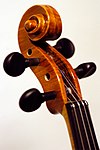
An electric guitar is a guitar that requires external amplification in order to be heard at typical performance volumes, unlike a standard acoustic guitar. It uses one or more pickups to convert the vibration of its strings into electrical signals, which ultimately are reproduced as sound by loudspeakers. The sound can be shaped or electronically altered to achieve different timbres or tonal qualities, making it quite different from an acoustic guitar. Often, this is done through the use of effects such as reverb, distortion and "overdrive"; the latter is considered to be a key element of electric blues guitar music and rock guitar playing.

The guitar is a fretted musical instrument that typically has six strings. It is held flat against the player's body and played by strumming or plucking the strings with the dominant hand, while simultaneously pressing the strings against frets with the fingers of the opposite hand. A plectrum or individual finger picks may be used to strike the strings. The sound of the guitar is projected either acoustically, by means of a resonant chamber on the instrument, or amplified by an electronic pickup and an amplifier.
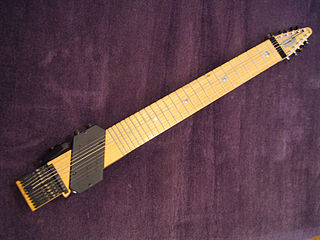
The Chapman Stick is an electric musical instrument devised by Emmett Chapman in the early 1970s. A member of the guitar family, the Chapman Stick usually has ten or twelve individually tuned strings and is used to play bass lines, melody lines, chords, or textures. Designed as a fully polyphonic chordal instrument, it can also cover several of these musical parts simultaneously.
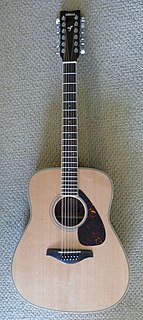
A twelve-string guitar is a steel-string guitar with 12 strings in six courses, which produces a thicker, more ringing tone than a standard six-string guitar. Typically, the strings of the lower four courses are tuned in octaves, with those of the upper two courses tuned in unison. The gap between the strings within each dual-string course is narrow, and the strings of each course are fretted and plucked as a single unit. The neck is wider, to accommodate the extra strings, and is similar to the width of a classical guitar neck. The sound, particularly on acoustic instruments, is fuller and more harmonically resonant than six-string instruments.
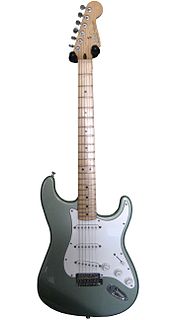
The Fender Stratocaster, colloquially known as the Strat, is a model of electric guitar designed from 1952 into 1954 by Leo Fender, Bill Carson, George Fullerton and Freddie Tavares. The Fender Musical Instruments Corporation has continuously manufactured the Stratocaster from 1954 to the present. It is a double-cutaway guitar, with an extended top "horn" shape for balance. Along with the Gibson Les Paul, Gibson SG and Fender Telecaster, it is one of the most-often emulated electric guitar shapes. "Stratocaster" and "Strat" are trademark terms belonging to Fender. Guitars that duplicate the Stratocaster by other manufacturers are sometimes called S-Type or ST-type guitars.

An eight-string guitar is a guitar with two more strings than the usual six, or one more than the Russian guitar's seven. Eight-string guitars are less common than six- and seven-string guitars, but they are used by a few classical, jazz, and metal guitarists. The eight-string guitar allows a wider tonal range, or non-standard tunings, or both.
The Fender Jaguar is an electric guitar by Fender Musical Instruments characterized by an offset-waist body, a relatively unusual switching system with two separate circuits for lead and rhythm, and a short-scale 24" neck. Owing some roots to the Jazzmaster, it was introduced in 1962 as Fender's feature-laden top-of-the-line model, designed to lure players from Gibson. During its initial 13-year production run, the Jaguar did not sell as well as the less expensive Stratocaster and Telecaster, and achieved its most noticeable popularity in the surf music scene. After the Jaguar was taken out of production in 1975, vintage Jaguars became popular first with American punk rock players, and then more so during the alternative rock, shoegazing and indie rock movements of the 1980s and 1990s. Fender began making a version in Japan in the mid-1980s, and then introduced a USA-made reissue in 1999. Since then, Fender has made a variety of Jaguars in America, Mexico, Indonesia and China under both the Fender and Squier labels. Original vintage Jaguars sell for many times their original price.
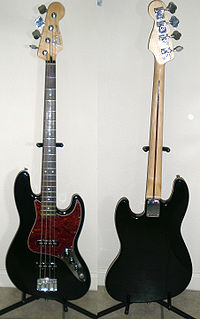
The Fender Jazz Bass is the second model of electric bass created by Leo Fender. It is distinct from the Precision Bass in that its tone is brighter and richer in the midrange and treble with less emphasis on the fundamental frequency. The body shape is also different from the Precision Bass, in that the Precision Bass has a symmetrical lower bout on the body, designed after the Telecaster and Stratocaster lines of guitars, while the Jazz Bass has an offset lower bout, mimicking the design aesthetic of the Jaguar and Jazzmaster guitars.
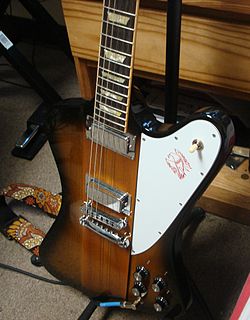
The Gibson Firebird is a solid-body electric guitar manufactured by Gibson from 1963 to the present.

Steinberger is a series of distinctive electric guitars and bass guitars, designed and originally manufactured by Ned Steinberger. The name "Steinberger" can be used to refer to either the instruments themselves or the company that originally produced them. Although the name has been applied to a variety of instruments, it is primarily associated with a minimalist "headless" design of electric basses and guitars.

The yueqin or yue qin, formerly romanized as yüeh-ch‘in and also known as the moon guitar, moon lute, gekkin, wolgeum, or la-ch‘in, is a traditional Chinese string instrument. It is a lute with a round, hollow wooden body which gives it the nickname moon guitar. It has a short fretted neck and four strings tuned in courses of two, generally tuned to the interval of a perfect fifth. Occasionally, the body of the yueqin may be octagonal in shape. It is an important instrument in the Peking opera orchestra, often taking the role of main melodic instrument in lieu of the bowed string section. The frets on all Chinese lutes are high so that the fingers never touch the actual body—distinctively different from western fretted instruments. This allows for a greater control over timbre and intonation than their western counterparts, but makes chordal playing more difficult.
An extended-range bass is an electric bass guitar with a wider frequency range than a standard-tuned four-string bass guitar.

A multi-neck guitar is a guitar that has multiple fingerboard necks. They exist in both electric and acoustic versions. Although multi-neck guitars are quite common today, they are not a modern invention. Examples of multi-neck guitars and lutes go back at least to the Renaissance.

An experimental musical instrument is a musical instrument that modifies or extends an existing instrument or class of instruments, or defines or creates a new class of instrument. Some are created through simple modifications, such as cracked drum cymbals or metal objects inserted between piano strings in a prepared piano. Some experimental instruments are created from household items like a homemade mute for brass instruments such as bathtub plugs. Other experimental instruments are created from electronic spare parts, or by mixing acoustic instruments with electric components.

The Gibson L6-S is a solid body electric guitar. It was the working musician's descendant of the L5S jazz solid-body electric guitar. It was the same shape, very much like a wide Gibson Les Paul, but with a 24-fret two-octave neck, the first Gibson guitar to have this.
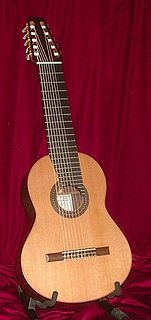
There are many varieties of ten-string guitar, including:
String resonance occurs on string instruments. Strings or parts of strings may resonate at their fundamental or overtone frequencies when other strings are sounded. For example, an A string at 440 Hz will cause an E string at 330 Hz to resonate, because they share an overtone of 1320 Hz.

Experimental luthiers are luthiers who take part in alternative stringed instrument manufacturing or create original string instruments altogether.
The Yamaha Corporation is a multinational corporation and conglomerate based in Japan with a wide range of products and services, predominantly musical instruments, motorcycles, power sports equipment and electronics.
The Fender Telecaster, colloquially known as the Tele, is the world's first commercially successful solid-body electric guitar. Its simple yet effective design and revolutionary sound broke ground and set trends in electric guitar manufacturing and popular music. Introduced for national distribution as the Broadcaster in the autumn of 1950 as a two-pickup version of its sister model, the single-pickup Esquire, the pair were the first guitars of their kind manufactured on a substantial scale. A trademark conflict with a rival manufacturer's led to the guitar being renamed in 1951. Initially, the Broadcaster name was simply cut off of the labels placed on the guitars and later in 1951, the final name of Telecaster was applied to the guitar. The Telecaster quickly became a popular model, and has remained in continuous production since its first incarnation.
















